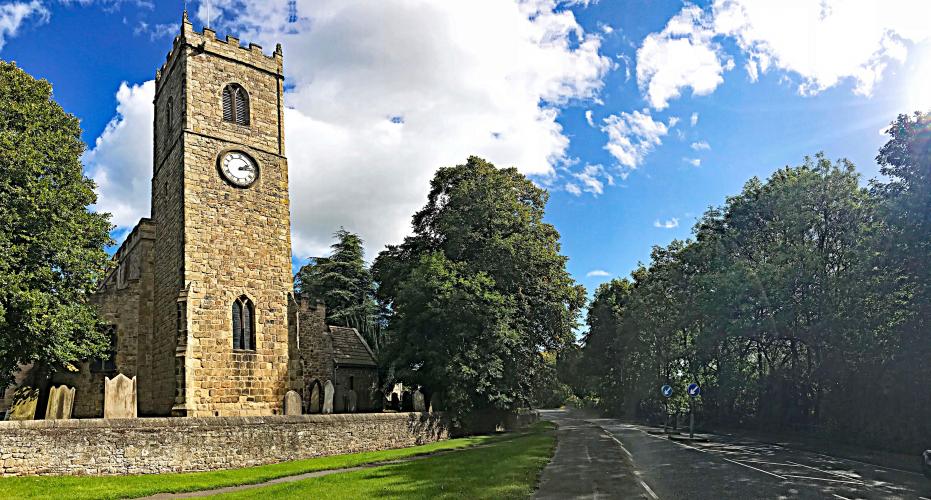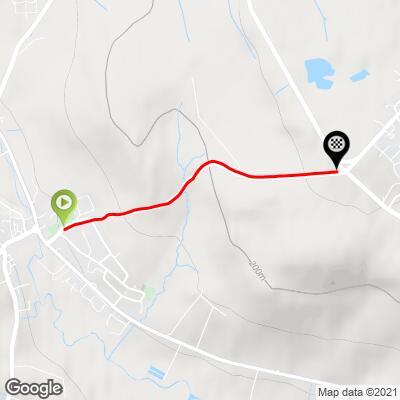![Peth Bank #60 Simon Warren 100 Greatest Cycling Climbs Cycling Peth Bank #60 Simon Warren 100 Greatest Cycling Climbs - All Saints Parish - 100 Greatest Cycling Climbs logo]()
All Saints Parish[1] - Near start of climb
This climb is named after the neighborhood (Peth Bank) the climb passes mid way up Peth Bank Lane.
Peth Bank is a fairly short but challenging climb at 1.7 kilometers averaging 8.6% grade. The challenge begins from the start with an 8% grade turning to 18% for 200 meters from the 100-300 meter marks - the first 400 meters averages a rugged 13.6%. This followed by 300 meters at 3 ½ %, jumping to 8% for the final kilometer.
![Peth Bank #60 Simon Warren 100 Greatest Cycling Climbs Bike climb Peth Bank #60 Simon Warren 100 Greatest Cycling Climbs - steep grade sign and road]()
First 400 meters are steee - eeeep!
![Peth Bank #60 Simon Warren 100 Greatest Cycling Climbs Bicycle ride Peth Bank #60 Simon Warren 100 Greatest Cycling Climbs - giant wheel with bike and pjamm]()
Finish of the climb
![Peth Bank #60 Simon Warren 100 Greatest Cycling Climbs]()
![]()
Steepest ½ kilometer begins at at the very start (12.7%)
#60 of the 100 Greatest Cycling Climbs (Britain) - this one begins at the eastern edge of Lanchester, County Durham (population 4,054, 2011):
“Lanchester is a village and civil parish in County Durham, England, and was in the former district of Derwentside (1975–2009). It is 8 miles (13 km) to the west of the city of Durham and 5 miles (8 km) from the former steel town of Consett, and has a population of slightly more than 4,000,[1] measured at the 2011 Census as 4,054.
Although there was a small drift mine on the edge of the village which closed in the 1970s, Lanchester's economy was mainly based on agriculture. It is now a residential village in which a number of housing estates have been developed since the late 1960s. The village centre now has three pubs and a small shopping centre. Thanks to the Lanchester Partnership, a cycle track was opened on 25 April 2009.
History
The earliest occupation on the site is the Roman auxiliary fort located just southwest of Lanchester (grid reference NZ159469. Longovicium lay on the Roman road leading north from Eboracum (York), known as Dere Street. It is situated between the forts of Vindomora (Ebchester) and Vinovia (Binchester). The fort dates to AD 140,[3] covers almost 6 acres (2.4 ha), and housed around 1,000-foot soldiers and cavalry. The fort foundations are well preserved, but there has only been minor excavation work carried out in 1937.
Stone from the fort was used in the construction of All Saints' Church, which has a Roman altar (one of many found in or near the fort) which was found near the fort in 1893 in its porch.
Andrew Breeze has argued that the Battle of Brunanburh took place at the Roman fort of Longovicium. He interprets Brunanburh as meaning 'stronghold of the Browne.” Wikipedia - Lanchester, County Durham
Top 10 things to do around Lanchester.
100HillsForGeorge.blogspot.com:
“Hill no 51 – 60 Peth Bank
A bit of a contrast this one as it actually started somewhere relatively “urban”. When I say relatively “urban”, I do mean in comparison to the riding I had been doing the last few days – Lanchester was a pretty sleepy, pretty little town, but it was a thriving metropolis compared to where we’d been.
A cyclist was heading up the road before me – which was nice (because in the back of your mind there is always a target to chase down).
The heat was pretty amazing – the road was “sticky” and you could feel the squidge of the tar being soft under the bike – it was even sticking to the tyres a bit and picking up stones. I did resent this extra weight that I was carrying.
Again, another hill that was steep at the very start, but there was a nice bit through trees which I really enjoyed – the open climbs are amazing for views etc, but I just find the climbs through trees more enjoyable for some reason.
little bit of a false finish and I saw the guy ahead of me, which really gave me the impetus to press down on the pedals, the little windy turns meant I lost sight of him every now and then, but I caught him, regulated my breathing and gave a cheery greeting (trying not to let him know how hard I had been working!).” More
CyclingUphill.com:[2]
“A great climb near Durham, Teeside, north east. This starts just off the A691 in the village of Lanchester. After passing the church on your left, the climb rears up to over 20% as you go around a left hand corner. Getting through this corner will give some relief as the gradient eases off and becomes flat for a brief period at 0.5 miles. However it’s a climb of two halves as the gradient picks up again – not as steep at the bottom, but averaging a good 8-10% for the final half a mile to the top. As you near the top, you will come out of the trees to see great views of the surrounding countryside.” More
[1] “The main Parish church is now known as All Saints but was once called St. Mary the Virgin. The original building dates from the mid 12th Century but was extended in 1284 by Antony Bek, the bishop of Durham. The tower dates from c.1430. Features of interest include the Norman chancel arch, the monolithic columns of the nave (presumably from the Lanchester Roman station)and a Roman altar in the porch.” Wikipedia - Lanchester
[2] We have high regard for Tejvan’s blog - it is exceptional! On this one isolated instance are 2 corrections to be noted (a) the climb is “Peth” not “Perth” Bank and (b) the Strava/VeloViewer widgets are for Cheddar George, not Peth Bank.

 We've partnered with Sherpa-Map.com to bring you the best route planning tool. With a PRO Membership you can use this climb as a reference when creating your route.
We've partnered with Sherpa-Map.com to bring you the best route planning tool. With a PRO Membership you can use this climb as a reference when creating your route. 

